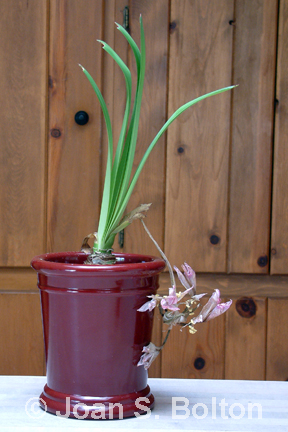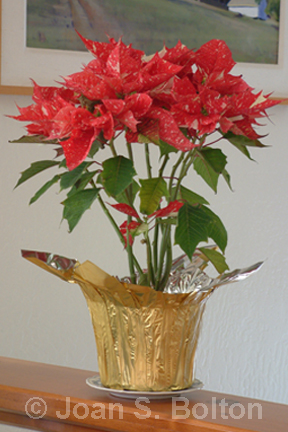
Are any of your holiday houseplants still in decent shape?
My fancy, pink-splattered poinsettia is hitting three months and going strong.
But the spectacular, candy cane-striped trumpet flowers of my amaryllis (actually a Hippeastrum hybrid) are a distant memory. It may seem a little warped to display a photo of the dried remains. But that’s an inevitable sight — unless I lose patience and toss the lemon-sized bulb into the compost.
But at $10 to $25 a pop, my inclination is to try to keep it going.
Here’s the Drill
In the garden, amaryllis bloom in the spring, right before or just as their broad, strappy leaves emerge. If yours bloomed this past Christmas, it’s not likely to produce more flowers this spring. The bulbs can take more than a year to acclimate.
In the meantime, they’re finicky about watering, drainage and keeping their necks dry. Given my heavy soil, planting them in the ground isn’t an option. Instead, they’re best planted in a fast-draining cactus mix in a small, simple red clay pot, with just an inch or two between the rough, papery edges of the bulb and the side of the pot. The bulbs should also be high, with up to half of their tops exposed to the world.
With filtered sunlight and occasional water, agapanthus-like leaves should emerge in spring. When the leaves begin to yellow, I’ll stop watering and let the bulbs dry out over summer. Flower buds should be forming, deep within, during this rest period. New, succulent flower stalks should then — hopefully — rise and bloom the following spring.

What About Poinsettias?
Somehow, poinsettias seem to be easier to dump after Christmas. Maybe because they’re less exotic, don’t cost as much and have already held strong indoors for several months before tiring.
But poinsettias are native to Mexico and will grow well outdoors on the Central Coast.
However, long nights are what triggers their coloring, so they’re not likely to turn red until after Christmas. They also tend to stretch outdoors, growing leggier by the year. I’ve seen the yellow-leaf types reach 10 feet tall in older neighborhoods.
Easy in the Garden
If you’d like to plant your poinsettias outdoors, wait until spring.
In the meantime, put your plants — still in their pots — in a protected patio or garage. After the leaves fall off, cut down the stems to a few inches tall. Go easy on the water.
When temperatures begin to warm up, plant your plants in a sunny spot that’s out of the wind, protected from frost, has good to excellent drainage and offers plenty of head room. While fresh pot plants may only be a foot or two tall, most poinsettias in the garden revert to head-high or higher, unless you pinch back the stems on a regular basis.
Mulch your plants and water occasionally. Some folks say it’s not necessary to fertilize outdoor poinsettias. Others recommend applying a high-nitrogen fertilizer twice a month once the leaves begin to turn red.
Left to their own devices, poinsettias can look pretty scraggly for the first few feet out of the ground. If you don’t pinch back every few weeks during the growing season, plant something in front to hide their ankles and knees.
The “bloom” is a result of the colored bracts, or modified leaves, responding to long nights. Poinsettias need about 12 hours of darkness to trigger the change in color. The leaves then take 2 to 3 months to mature, depending on the variety, temperature and intensity of light.
If your poinsettias are planted near an all-night patio light or streetlight, they may not bloom until well into the new year. Commercial growers manipulate the light to create plants ready to sell from Thanksgiving through Christmas.
A Lot More Trouble
If you’re dead-set on getting a poinsettia to rebloom in December, keep it in its pot so that you can manipulate its daylight hours.
After the leaves drop, cut back the stems to 6 inches high. Make sure each stem has at least two joints. Set the plant outdoors in a sunny location. Water whenever the top few inches of soil dry out, and pinch back new growth every few weeks to encourage fullness.
The real fun begins in October.
Place the pot in a pitch-black closet every night for 14 hours, say from 5 p.m. to 7 a.m. Then put it in sunshine during the day, for 10 hours.
I’ve never had the discipline to follow through. But maintaining the regimen for eight to 10 weeks is said to result in a colorful plant for Christmas.
≈
Copyright, Joan S. Bolton. All rights reserved. Reproduction of text or photos in any form is prohibited without written permission.
≈
